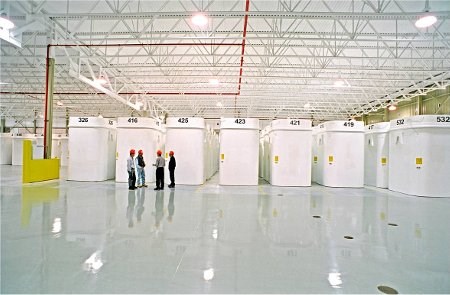Storing nuclear waste in the deep confines of the Canadian Shield has always evoked a basic gut level reaction from Northerners.
Officials from a federal organization tasked with finding a socially, technically and environmentally-acceptable home for spent nuclear fuel are hitting the road this spring and summer to speak to Canadians.
A draft document on the site selection process for a proposed nuclear waste storage facility is being released by the Nuclear Waste Management Organization (NWMO) in May for public review. NWMO spokesman, Mike Krizanc, said his organization is a long way from short-listing any prospective sites or communities and is not yet inviting any formal expressions of interest.
A March presentation by NWMO officials as an invited speaker at Thunder Bay's Lakehead University was in no way a pre-emptive toe in the water to identify that city as a possible host, said Krizanc.
"We respond to invitations all the time," he said of the NWMO's upcoming public engagements in Saskatchewan. "We're very interested in getting the story out...and we never say no to an opportunity."
While the debate surrounding nuclear waste disposal always creates public trepidation, the organization wants to be as pro-active, transparent and forthcoming with information as possible.
Public acceptance is key before anything gets built anywhere, said Krizanc. Adaptive Phased Management is the buzz phrase used by the NWMO to describe the baby steps being taken to find an "informed and willing" host community over the next several years.
The process is so all-inclusive, it includes a vital First Nations element.
"There's absolutely nowhere you can go in this country that's not going to involve Aboriginal people," said Laurentian University engineering professor Dr. Dougal McCreath, who serves on NWMO's advisory panel. "It's important to work with them and gain mutual understanding."
The document released this spring for public review will not name specific places, only the criteria for choosing them. The eventual start of the site selection process begins sometime after 2009. The entire process will be so sensitive to people's concerns, a host community reserves the right to withdraw at the last minute. Just working through the final consultation process can take as many as six to eight years.
Canada's plan is for one central repository for all of its nuclear fuel. The four provinces where nuclear generation is used or being considered, Ontario, Quebec, Saskatchewan and Manitoba, would be the likely place for storage.
Since the beginning of Canada's nuclear program 40 years ago, some two million bundles of spent fuel have been created. It is stored at six interim sites in Canada. Four are located in Ontario, and one each in Manitoba, Quebec and New Brunswick. All but one are located at nuclear power plants.
"There's no urgency to move this material quickly, we have the time to do it right," said Krizanc. But there is momentum to do the socially responsible thing and not leave nuclear waste as a legacy for future generations to tackle.
Reactor sites were never meant to be a final repository. Safety and security is a top priority, but "fairness and ethics" also come into play. Nuclear plants sites were chosen for their proximity to water, not for waste storage.
"In some of these communities there is an expectation (from citizens) that the used fuel would be removed from there eventually," said Krizanc. Deep underground repositories are internationally accepted as the way to go. Finland expects to have a facility operational by 2020, with Sweden, Germany and France to follow.
Wherever a Canadian facility is built, it will be an impressive multi-million-dollar feat of engineering and design. It would be as deep as 500 metres in a granite or sedimentary rock formation.
"A very high-tech infrastructure project (will be) implemented over many decades involving many hundreds (of) high-end jobs," with site prep, construction, operations and monitoring, said Krizanc. Abandoned mine shafts are being ruled out since underground blasting creates fissures in the rock. The preference is for "virgin" ground with little likelihood of finding valuable minerals in the area.
Laurentian's McCreath, who journeys to Toronto four times a year to meet with the panel, has been giving his technical know-how to NWMO on the site criteria.
"They've been working fairly hard in focus groups, IPSO Reid poll groups and community meetings to explain and dispel the myths out there," he said.
In CANDU reactors, each fuel bundle is about the size of a fireplace log. Hundreds are stacked in a reactor. After an 18-month lifespan they are removed by remote control as highly radioactive material and submerged into cooling ponds for seven to 10 years. The bundles remain radioactive when placed inside giant steel and concrete-reinforced casks for dry storage. Any measured outside radiation is no more than what's found in the natural environment, said Krizanc.
The NWMO's annual report will be posted on its website in late March.




